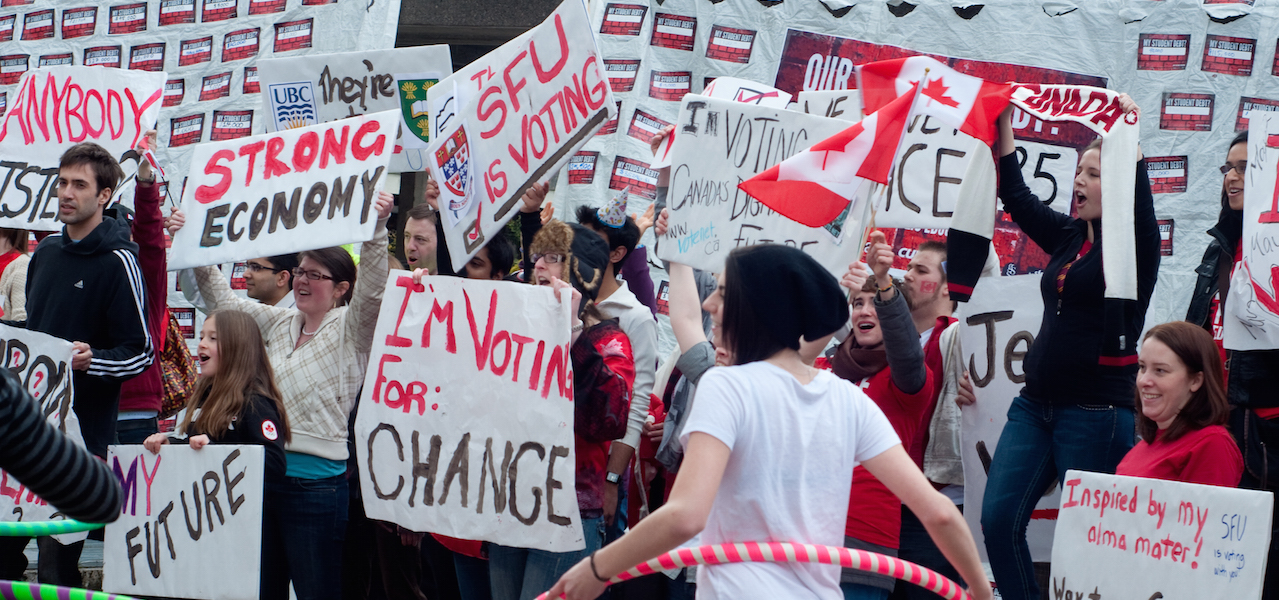The CCPA-BC sent the following submission to the BC Government’s How We Vote consultation, which requests feedback on key elements of the upcoming referendum on electoral reform. Written submissions are being accepted from now until February 28, 2018. You can feel free to quote or cite any of the following if you choose to submit comments of your own.
Thank you for this opportunity to share our recommendations regarding the electoral reform process in British Columbia. We hope our contributions are useful for your deliberations.
In the interest of full disclosure: we support electoral reform and believe the province and good public policy-making would benefit from a move to proportional representation (PR). We are very pleased that the government is holding a public referendum in fall 2018, and we are agnostic on the question of which form of PR should replace First Past The Post (FPTP). Indeed, our core recommendation is that British Columbians themselves be given the opportunity to decide which model they prefer. It is our strong contention that the public must see the final decision as stemming from the choices of British Columbians themselves, and not the result of politicians or political parties privileging a particular alternative.
Our recommendations
1. The ballot structure
We recommend that a two-question ballot be put before British Columbians in fall 2018.
The first question should be simple and straightforward, asking people if they would like to maintain BC’s current FPTP electoral process or change to a form of PR.
The second question should ask, if a majority vote to change the electoral system to proportional representation, which form of PR would you prefer?
This second question should offer a list of PR models and ask people to rank their choices. Then a ranked-ballot transferable vote calculation can be used to select the most-preferred option. In this manner, all British Columbians can have a say on their preferred PR choice (including those who may have voted in favour of FPTP on the first question). This approach will also ensure that people can have confidence that citizens are choosing the preferred alternative, rather than politicians.
The benefit of this two-question ballot approach is that the first question will provide clarity on whether people want a change to PR from FPTP, without confusing the matter by splitting the choices between more than two options. This also means that those who want PR are not forced to vote in favour of a particular PR model that is not their preference; for example, in the 2005 and 2009 BC referenda, PR advocates who favoured Mixed Member Proportional but were not keen on the Single Transferable Vote were not given this option.
2. Public education
British Columbians will require clear and impartial information and education on the various electoral models. Given this, we recommend the government provide Elections BC with a clear mandate and additional funding to undertake this educational work. Also, Elections BC should consult with academics with varying views on electoral reform, to ensure the materials produced are impartial. The final materials must be clear to a lay audience.
3. A level playing field
The electoral reform campaign and debates must occur on a level playing field. In order to accomplish this, we recommend:
- The government provide a modest level of public funding to one proponent group (in favour of PR) and one opponent group (in favour of FPTP). This funding can be used as the groups see fit (for staffing, advertising or vote mobilization).
- Beyond this public funding, third party referendum-related advertising be capped at $100,000 over a three-month period leading up to the referendum’s closing date. Importantly, however, third parties should only be required to register once they spend $5,000 on province-wide advertising or $1,500 within a single constituency. Limits on third party advertising can help create a more level democratic playing field, but need to effectively target big spenders. Groups and individuals should be able to expend modest sums on referendum advertising without having to register, given that such modest sums are unlikely to distort the public debate and deliberation process. The imposition of a “register first, speak second” rule unnecessarily complicates and constrains the free speech rights of small spenders (precisely the opposite impact such rules ought to have). This recommendation is consistent with past research on the impacts of BC’s third party election advertising rules conducted by the CCPA-BC, the Freedom of Information and Privacy Association and the BC Civil Liberties Association.1
4. PR options on the ballot
Regarding the PR options put before British Columbians: assuming that a second question on the ballot lists different PR options to be ranked, it is important that a representative but manageable sample of models be offered.
We note that in the government’s current questionnaire, the following PR options are listed:
- List Proportional Representation
- Single Transferable Vote (STV)
- Mixed Member Proportional (MMP)
- Mixed Member Majoritarian
The “List Proportional Representation” model and the “Mixed Member Proportional” model in the survey amalgamate both “closed-list” and “open-list” options. We believe this is a mistake. Open and closed lists are quite different, and voters may have strong preferences for one or the other. In particular, we suspect many voters who wish for more decision-making for citizens rather than for parties will have a strong preference for an open list. Therefore, we recommend that only “open list” options be put before voters.
We also recommend dropping the “List Proportional Representation” model from the list of options. We are not aware of any group that has called for this option, as virtually all PR advocates support some form of combining local or regional representation under PR. Including this option is therefore distracting and makes the list of models needlessly complicated.
Similarly, we note that Mixed Member Majoritarian does not belong among the options. While this model produces results that are more proportional than FPTP, it may or may not produce results that are truly proportional and may continue to produce false majorities. Given that too many options on the ballot can cause unnecessary confusion and distraction, we recommend this option also be excluded.
On the other hand, there are some PR models not included in the government’s survey that likely do merit inclusion on a ranked ballot question. In particular, both “Local PR” (a system that, like STV, would see larger multi-member electoral districts, but where each existing riding still emerges with a representative), and “Rural-Urban PR” (a hybrid model of MMP and STV with multi-member ridings in urban areas, single-member ridings in rural areas, and a smaller number of regional top-up seats to ensure a proportional outcome) options merit inclusion.
Thus, we recommend the second question on the ballot include four PR options:
- Mixed Member Proportional – Open List
- Single Transferable Vote
- Local PR
- Rural-Urban PR
The ballot packages mailed to voters should include an info card with short descriptions of these four options.
5. Use of a “citizens’ jury”
In order for British Columbians to have maximum confidence that political parties are not biasing the referendum process, we recommend that Elections BC assemble a “Citizens’ Jury” or “Citizen Panel”, made up of volunteers randomly selected from across the province, and empower this group to make some key final decisions. Specifically, this citizen group should:
- Have final sign off on the system choices and wording of the ballot.
- After the referendum, and if PR is chosen by BC voters, this group would be re-convened to oversee implementation of the option chosen and to decide on the number and allocation of new seats in the BC legislature (see recommendation 6).
Citizens’ juries2 and similar deliberative democracy models have been used in a wide range of countries including Canada, the United States, Britain and Australia, and they have weighed in on a wide variety of important public policy issues, including how we vote.
For example, the City of Edmonton convened a citizens’ jury to consider whether it should implement a system of online voting.3 The citizens’ jury was widely seen as successful and reached a high level of agreement, although city council declined to implement their recommendation in favour of online voting.
6. Number of seats in the Legislature
A complicating factor in the referendum, with the potential to alter the outcome and choices, is the matter of the number of seats in a new Legislature. Voters’ opinions about a switch to PR, and their views on which PR alternative is preferable, may be impacted by their desire to see a mixed model in which sufficient local representation is maintained. The capacity for local representation may, in turn, be limited by the number of seats in the next legislature. For example, under an MMP model, without an increase in the number of seats, local ridings would have to be made substantially larger. On the other hand, if the lists are made regional, this may help to alleviate some people’s concerns.
If this matter is not addressed prior to the referendum, people will be asked to make a decision under too much uncertainty, and those who oppose PR will campaign on a claim that PR will erode or eliminate local representation, when this may not be true.
Given this, we recommend the government do the following:
- Indicate ahead of the referendum that PR will likely necessitate the establishment of additional seats.
- Indicate ahead of the referendum that if PR is chosen, any list-based seats will be regionally composed, thereby maintaining regional representation.
- Commit that, if PR is chosen, the government will reconvene and empower a citizen panel after the referendum to determine if additional seats are needed in the legislature, and if so, how many, and that the independent Electoral Boundaries Commission will be tasked with allocating such seats.
7. Confirmation referendum
In order to allay concerns that some may have about a change to the electoral system, we recommend that the government commit prior to the fall 2018 referendum that, if a change is instituted, a follow-up referendum will be held after two election cycles. This will give the public a chance to revisit the switch to PR having seen it in practice, and provide them with an opportunity to switch back to FPTP if that is the public’s will. This will allow people to say “yes” to change with less risk, and then test the new system.
**
Thank you again for your consideration of our views on this important subject.
Notes
- For more see: https://www.policyalternatives.ca/publications/reports/election-chill-effect
- For more on citizens’ juries and how they operate, see: https://participedia.net/en/methods/citizens-jury, http://www.rachel.org/files/document/Citizens_Jury_Handbook.pdf, and http://www.civicus.org/documents/toolkits/PGX_B_Citizens%20JuryFinalWeb.pdf.
Notably, there are political scientists in BC who have studied how to conduct citizen juries. - For more see: http://www.revparl.ca/36/2/36n2_13e_Kamenova-Goodman.pdf






